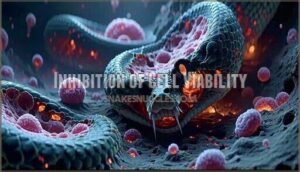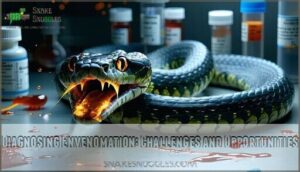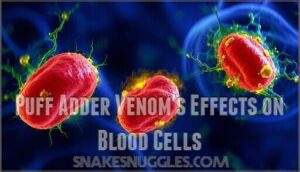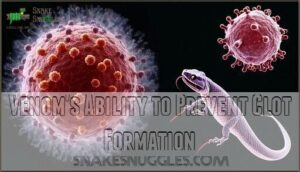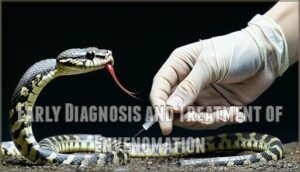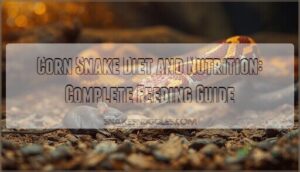This site is supported by our readers. We may earn a commission, at no cost to you, if you purchase through links.

The venom contains deadly toxins like Bitanarin and Ba100 that’ll damage your tissue, disrupt nerve signals, and mess with your blood’s ability to clot properly.
You’ll experience muscle weakness as the venom blocks nerve-muscle communication, while your blood platelets get destroyed and clotting times become dangerously prolonged.
The cytotoxic effects don’t stop there – they’ll kill your muscle cells directly and can prevent your blood from forming protective clots when you need them most.
Understanding these mechanisms reveals why quick medical intervention becomes absolutely critical to address the cytotoxic venom effects.
Table Of Contents
- Key Takeaways
- Puff Adder Venom Toxicity
- Effects on Nerve and Muscle Tissue
- Cytotoxic Effects on L6 Skeletal Muscle Cells
- Impact on Blood Coagulation and Platelets
- Diagnosing Envenomation: Challenges and Opportunities
- Puff Adder Venom’s Effects on Blood Cells
- Thromboelastography and Clot Prevention
- Early Diagnosis and Treatment of Envenomation
- Prevention and Prognosis of Puff Adder Snake Bites
- Additional Information on Puff Adder Snake Bites
- Frequently Asked Questions (FAQs)
- What are the effects of puff adder venom?
- What does cytotoxic venom do to the body?
- Is puff adder cytotoxic?
- What does adder venom do to you?
- What are the effects of cytotoxic snake venom?
- How toxic is a puff adder?
- What does adder venom do?
- What happens if puff adder venom enters the bloodstream?
- How does puff adder venom affect the immune system?
- Can puff adder venom be transmitted through other means?
- Conclusion
Key Takeaways
- You’ll face severe tissue destruction – The venom’s cytotoxins, like Bitanarin and Ba100, directly kill muscle cells and cause widespread tissue necrosis around the bite site.
- Your blood won’t clot properly – Puff adder venom destroys platelets, prevents fibrin clot formation, and creates dangerous bleeding disorders that can lead to hemorrhage.
- You’ll experience muscle weakness and paralysis – The venom blocks nerve-muscle communication and directly damages muscle tissue, potentially causing respiratory failure.
- You need immediate antivenom treatment – SAIMR antivenom must be administered quickly to neutralize the deadly toxins before they cause irreversible damage to your blood, muscles, and organs.
Puff Adder Venom Toxicity
The puff adder’s venom packs one of nature’s most potent cocktails of death—with an LD50 of just 9-13 micrograms per mouse, it’s among the deadliest viper venoms on Earth.
This toxic brew contains specialized proteins like Bitanarin, Bitiscetin, and Ba100 that work together like a molecular demolition crew, systematically destroying tissues and disrupting your body’s most essential functions, which can be described as a potent cocktail.
LD50 and Venom Composition
The puff adder’s venom packs a deadly punch with an LD50 of 9-13 µg/mouse, ranking among the most toxic viper venoms.
This complex biochemical cocktail contains multiple cytotoxin effects that trigger tissue necrosis and bleeding.
The venom composition includes metalloproteinases, phospholipases, and coagulotoxins working together to create devastating murine toxicity.
Venom variance across geographic regions doesn’t substantially impact potency, maintaining consistent toxic levels that demand immediate medical intervention.
Understanding the snake venom toxins is vital for developing effective treatments against their deadly effects.
Bitanarin, Bitiscetin, and Ba100 Toxins
Three deadly toxins turn puff adder venom into a biological weapon.
These cytotoxic pathways create devastating effects:
- Bitanarin: Post-synaptic neurotoxin disrupting nerve transmission
- Bitiscetin: Induces dangerous platelet aggregation and clotting
- Ba100: Fibrinogenase activity breaks down essential clotting proteins
- Combined effect: Toxin interactions overwhelm natural venom resistance
Understanding these toxin mechanisms helps improve antivenom efficacy against puff adder venom’s cytotoxic effects.
PLA2 Activity and Fibrogenase Effects
The phospholipase A2 (PLA2) activity in puff adder venom hydrolyzes membrane phospholipids, causing cellular damage and inflammation.
Meanwhile, fibrogenase effects disrupt blood coagulation by cleaving fibrinogen molecules.
These enzyme interactions create devastating toxin pathways—PLA2 destroys cell membranes while fibrogenase prevents clot formation, making this cytotoxic venom particularly dangerous through dual mechanisms.
Effects on Nerve and Muscle Tissue
When you encounter a puff adder bite, the venom’s neurotoxic and myotoxic components immediately begin attacking your nerve and muscle systems.
You’ll experience nerve damage that disrupts electrical signals to muscles, while direct muscle toxicity causes weakness and potential paralysis.
Neurotoxicity and Myotoxicity
Beyond the immediate tissue damage, puff adder venom attacks your nervous system and muscles through distinct pathways.
Neurotoxicity causes nerve damage by disrupting signal transmission, while myotoxicity leads to muscle weakness through cellular destruction.
These toxicity mechanisms work together to create devastating effects:
- Nerve conduction slows dramatically, weakening muscle contractions
- Direct muscle twitches decrease as cytotoxic effects take hold
- Baseline muscle tension drops, affecting overall function
- Venom toxicity can lead to respiratory failure without treatment
Inhibition of Nerve-Mediated Twitches
When puff adder venom enters your system, it systematically disrupts the electrical highways connecting your nerves and muscles.
This neurotoxic assault creates a cascade of cellular disruption that compromises your body’s ability to respond to danger.
The venom’s cytotoxic effects target nerve-mediated muscle contractions through several mechanisms:
- Nerve conduction velocity decreases dramatically, slowing signal transmission between neurons and muscle fibers
- Acetylcholine release becomes impaired at neuromuscular junctions, preventing proper muscle activation
- Calcium channel function deteriorates, disrupting the molecular machinery needed for muscle contraction
- Synaptic transmission fails as neurotoxic components bind to receptor sites and block normal communication
- Muscle fiber integrity degrades as twitch inhibition progresses, leading to widespread muscle weakness
This nerve damage creates a domino effect throughout your muscular system. The inhibition of nerve-mediated twitches represents one of puff adder venom’s most dangerous neurotoxic effects, potentially leading to respiratory paralysis without immediate antivenom treatment.
Decrease in Direct Twitches and Baseline Tension
Following nerve-mediated effects, puff adder venom disrupts muscle contractions directly.
You’ll experience weakened muscle responses as toxic effects reduce direct twitches while increasing baseline tension.
This cellular dysfunction creates muscle rigidity alongside decreased responsiveness.
Tissue necrosis may follow without prompt treatment, making antivenom administration essential for preventing permanent nerve impairment and muscle damage.
Understanding the role of neuromuscular blocking toxins is essential in addressing such venom effects.
| Venom Effect | Muscle Response | Clinical Impact |
|---|---|---|
| Direct twitch inhibition | Reduced contraction force | Weakness, paralysis |
| Baseline tension increase | Muscle rigidity | Stiffness, cramping |
| Cellular dysfunction | Membrane damage | Progressive deterioration |
| Tissue necrosis | Cell death | Permanent damage |
| Nerve impairment | Signal disruption | Loss of motor control |
Cytotoxic Effects on L6 Skeletal Muscle Cells
When you’re studying puff adder venom’s effects on muscle cells, you’ll find that L6 skeletal muscle cells become prime targets for the venom’s cytotoxic assault.
The venom doesn’t just attack your nerve pathways – it goes straight for your muscle cells’ ability to stay alive, turning healthy tissue into damaged, dying cells that can’t function properly, which is a result of the venom’s deadly effects.
Inhibition of Cell Viability
Puff adder venom’s cytotoxic effects create a cellular catastrophe within your muscle tissue.
The venom’s molecular interactions trigger rapid cell death through inhibition of cell viability, basically poisoning your cells from within.
Bitanarin and Ba100 cytotoxins orchestrate this toxic effects cascade, causing widespread tissue destruction.
Your skeletal muscle cells can’t survive this venom mechanism, making immediate treatment absolutely critical.
Role of Antivenom in Neutralizing Cytotoxicity
When cells start dying from puff adder venom, you’ll need antivenom to stop the damage. Antivenom Efficacy depends on binding specific cytotoxic venom effects through Toxin Binding mechanisms.
SAIMR antivenom demonstrates effective Venom Neutralization against puff adder venom cytotoxins in L6 skeletal muscle cells. Cytotoxic Reversal occurs when antivenom prevents cell death, but timing matters—delayed treatment won’t reverse established tissue damage.
Treatment Outcomes improve substantially with early administration. Understanding the venom variation factors is vital for developing effective antivenom strategies.
- You’re watching cells literally fight for survival against deadly toxins
- Every second counts before irreversible damage takes hold
- Antivenom acts like a molecular shield protecting your tissues
- Hope emerges when proper treatment neutralizes the venom’s assault
Impact on Blood Coagulation and Platelets
When you’re bitten by a puff adder, the venom doesn’t just attack your tissues—it wreaks havoc on your blood’s ability to clot properly.
The venom contains specialized proteins that simultaneously speed up clotting in some ways while completely disrupting it in others, creating a dangerous bleeding disorder that can quickly become life-threatening.
Procoagulant Effects and Clotting Times
When muscle cells suffer damage from cytotoxic effects, blood coagulation disorders soon follow.
Venom concentrations above 7.8 µg/100 µL plasma trigger procoagulant effects that dramatically reduce clotting times.
This creates a paradox—your blood clots too quickly initially, then fibrinolysis breaks down those clots, leading to dangerous bleeding.
Unfortunately, antivenom shows limited effectiveness against these coagulation changes, leaving patients vulnerable to thrombosis complications followed by severe bleeding episodes.
| Venom Concentration | Clotting Response |
|---|---|
| 0-7.8 µg/100 µL | Minimal impact on clotting times |
| 7.8-15 µg/100 µL | Moderate reduction in clotting times |
| 15-30 µg/100 µL | Significant procoagulant effects |
| 30+ µg/100 µL | Severe fibrinogenase activity |
| Post-clot formation | Platelet dysfunction and thrombocytopenia |
Inhibition of Platelet Aggregation
Blocking platelet aggregation creates a cascade of bleeding complications when puff adder venom enters your bloodstream.
This cytotoxic venom disrupts normal blood clotting through specific mechanisms:
- Arietin toxins block fibrinogen binding to platelet receptors, preventing aggregation
- Venom metalloproteinases damage platelet membranes, causing platelet dysfunction
- Coagulation disorders develop as normal hemostatic processes fail completely
These platelet inhibition effects make antivenom efficacy essential for preventing fatal hemorrhage.
Fibrinogenase Activity and Fibrin Clot Formation
Beyond platelet disruption, fibrinogenase activity compounds your bleeding crisis.
This venom enzyme systematically breaks down fibrinogen, preventing fibrin clot formation entirely.
Ba100 specifically targets fibrinogen molecules, creating coagulation disorders that anticoagulant therapy can’t reverse.
Your blood loses its natural clotting ability completely.
| Venom Component | Clotting Effect |
|---|---|
| Fibrinogenase | Prevents fibrin clot formation |
| Ba100 | Breaks down fibrinogen molecules |
| PLA2 enzymes | Disrupts fibrin fibre formation |
| Cytotoxic proteins | Damages coagulation pathways |
Diagnosing Envenomation: Challenges and Opportunities
When you’re facing a potential puff adder bite, rapid diagnosis becomes a race against time as venom spreads through your system.
Current diagnostic methods rely heavily on clinical observation and basic blood tests, but these can miss early signs of envenomation or fail to capture the full scope of venom’s impact on your blood cells and coagulation system.
Current Methods and Limitations
Diagnosing puff adder envenomation presents significant challenges in clinical settings. Current methods rely heavily on syndromic approaches, using clinical features to guide treatment decisions.
However, Diagnostic Challenges create critical gaps in accurate identification:
- Species identification remains subjective – distinguishing puff adder bites from other vipers proves difficult
- Laboratory constraints limit confirmation – standard coagulation tests require 3-4 hours and lack specificity
- Clinical overlap complicates diagnosis – symptoms mirror other snake envenomations, delaying targeted Medical Response
These limitations directly impact Antivenom Efficacy and Treatment Outcomes when cytotoxic effects from puff adder venom require immediate intervention.
Understanding venomous snake characteristics is essential for improving diagnostic accuracy and response times.
Potential Diagnostic Tools: Hematology Analyzer and Blood Smears
Advanced diagnostic markers through hematology tests and blood smears offer rapid detection of puff adder venom’s cytotoxic effects.
You’ll find hematology analyzers provide immediate platelet counts and cellular abnormalities, while blood smears reveal morphological changes from cytotoxins.
Laboratory analysis enables toxicity screening within minutes rather than hours.
The use of hematology analyzers involves understanding hematology analyzer systems.
- Early detection: Quick confirmation accelerates antivenom treatment, preventing severe tissue damage
- Cost-effectiveness: Rapid diagnosis reduces hospital stays and intensive care requirements
Puff Adder Venom’s Effects on Blood Cells
When puff adder venom enters your bloodstream, it launches a devastating attack on your blood cells that can quickly turn life-threatening.
You’ll experience a rapid drop in platelet counts, altered blood clotting functions, and widespread destruction of red blood cells that compromises your body’s ability to form protective clots.
Decrease in Platelet Numbers
Puff adder venom directly destroys your platelets, causing dramatic thrombocytopenia. Your platelet count plummets from normal levels around 223,500 to just 16,500 per microliter.
This cytotoxic effect leads to platelet disintegration, leaving only debris behind.
The venom’s coagulopathy disrupts blood clotting, creating serious bleeding risks that require immediate medical intervention.
Understanding the renal failure mechanisms is vital in addressing the severity of venomous bites.
Altered Platelet Function and Lyses Time
When you’re exposed to puff adder venom, your platelet aggregation gets disrupted, throwing your blood coagulation and hemostasis into chaos.
Platelet aggregation inhibitors like Arietin block fibrinogen binding, while altered platelet function increases lyses time in tests.
Thromboelastography reveals these cytotoxic effects prevent proper thrombosis, leaving you vulnerable to uncontrolled bleeding despite normal fibrinolysis pathways.
Eryptotic RBCs and Platelet Disintegration
Beyond platelet dysfunction, you’ll encounter severe blood cell destruction when exposed to puff adder venom.
The venom’s cytotoxic effects trigger widespread cellular damage through multiple pathways:
- Eryptosis Mechanism: RBC disintegration occurs via programmed cell death, creating eryptotic RBCs with altered membrane integrity.
- Platelet Damage: Direct cytotoxin exposure causes platelet disintegration, reducing functional platelet counts substantially.
- Venom Hemolysis: Cytotoxic effects destroy red blood cells, releasing hemoglobin and compromising oxygen transport throughout your system.
Thromboelastography and Clot Prevention
You’ll find that puff adder venom completely prevents blood clot formation, making thromboelastography (TEG) analysis show zero clot initiation even when thrombin is present.
The venom’s fibrinogenase activity breaks down fibrinogen so effectively that your blood can’t form the fibrin networks needed for proper clotting.
Venom’s Ability to Prevent Clot Formation
When blood flow becomes compromised, puff adder venom creates a perfect storm for coagulopathy.
The venom’s cytotoxic effects disrupt normal hemostasis by blocking fibrinolysis and preventing thrombosis formation. You’re witnessing anticoagulants in action as cytotoxic venom components systematically dismantle your body’s clotting machinery.
Antivenom efficacy becomes critical when puff adder venom cytotoxins override natural protective mechanisms. Understanding viper venom hemotoxicity is essential to develop effective treatments for snakebites.
Coagulation Parameter Effect of Puff Adder Venom
TEG Analysis and Coagulation Parameters
TEG analysis reveals how puff adder venom disrupts your blood’s clotting ability through detailed coagulation parameters. This diagnostic tool measures hemostasis dysfunction, showing cytotoxic effects on clot formation and fibrinolysis pathways.
- Coagulation disorders become evident through abnormal TEG tracings showing poor clot strength
- Thrombosis prevention occurs as venom blocks normal blood clotting mechanisms completely
- Thromboelastography analysis detects coagulation parameter changes within minutes of exposure
Understanding TEG analysis requires knowledge of TEG analysis tools to interpret results accurately.
Early Diagnosis and Treatment of Envenomation
When you’re bitten by a puff adder, every minute counts because the venom’s cytotoxic effects can cause irreversible tissue damage within hours.
You’ll need immediate antivenom administration, specifically SAIMR polyvalent antivenom, which neutralizes the deadly toxins before they destroy your blood cells and muscle tissue.
Importance of Rapid Diagnosis and Antivenom Administration
Understanding clot prevention mechanisms sets the stage for discussing time-sensitive treatment protocols.
Rapid diagnosis saves lives when you’re dealing with puff adder envenomation.
Medical response teams must recognize systemic symptoms within minutes, not hours.
Antivenom administration becomes less effective as venom-induced coagulopathy progresses.
| Timeline | Survival Rate |
|---|---|
| 0-2 hours | 95% with antivenom |
| 2-6 hours | 80% with antivenom |
| 6-12 hours | 60% with antivenom |
| 12+ hours | 48% untreated mortality |
Emergency care protocols emphasize immediate venom detection through clinical assessment rather than waiting for laboratory confirmation.
Role of SAIMR Antivenom in Neutralizing Venom Effects
SAIMR antivenom works by binding to specific toxins in puff adder venom, effectively neutralizing their cytotoxic effects.
Antivenom efficacy depends on proper SAIMR dosage and timing – you’ll see better treatment outcomes when it’s given quickly.
This venom neutralization process blocks toxins like Bitanarin and Ba100 from destroying your cells and tissues.
Antivenom administration literally saves lives by stopping the venom’s deadly cascade.
For those seeking more information on obtaining SAIMR Antivenom products, further resources are available.
Prevention and Prognosis of Puff Adder Snake Bites
You can substantially reduce your risk of puff adder bites by wearing protective clothing, avoiding snake habitats, and staying alert in endemic areas.
With prompt antivenom treatment, most patients recover fully, though delayed care increases complications like tissue necrosis and systemic toxicity.
Risk Factors and Predisposing Conditions
Several factors increase your risk of puff adder envenomation and severe cytotoxic effects.
Geographic location matters most – rural sub-Saharan Africa has highest exposure rates.
Key risk factors include:
- Age Factors: Children face greater venom concentration per body weight; elderly have compromised recovery
- Geographic Location: Rural areas with dense puff adder populations increase encounter probability
- Occupational Risks: Agricultural workers, herders, and outdoor laborers face highest exposure
- Climate Conditions: Rainy seasons increase snake activity and human-snake interactions
- Socioeconomic Status: Limited healthcare access delays antivenom treatment, worsening cytotoxic effects
Prevention Strategies and Outcomes/Resolutions
You can prevent puff adder bites through protective clothing and awareness in high-risk areas.
Medical intervention with antivenom administered promptly substantially improves outcomes.
Community education programs enhance public awareness about prevention strategies and emergency response protocols.
Most patients recover fully when cytotoxic effects are neutralized quickly through proper treatment.
Additional Information on Puff Adder Snake Bites
Understanding puff adder ecology and distribution helps you recognize high-risk environments and species behavior patterns.
These venomous snakes inhabit diverse African ecosystems, from savannas to rocky outcrops, with breeding cycles and territorial habits that influence human encounter rates, especially in high-risk environments.
Epidemiology and Distribution of Puff Adder Species
Puff adders dominate sub-Saharan Africa’s venomous snake epidemiology, spanning over 30 countries from Morocco to South Africa.
Their Geographic Range includes savannas, grasslands, and agricultural areas where Species Habitat overlaps with human settlements.
This Global Prevalence creates significant envenomation risks, with Venom Variance across regions affecting treatment outcomes.
Understanding distribution patterns helps predict Snake Migration and seasonal bite frequency throughout Africa.
Breeding, Behavior, and Habitat of Puff Adders
Three distinct habitat conservation zones support puff adder populations: rocky outcrops, dense vegetation, and open savannas.
These venomous snakes exhibit complex breeding patterns during spring mating season, with males displaying aggressive snake territoriality behaviors.
Their adder social structure remains largely solitary except during reproduction, and understanding puff adder behavior helps predict encounters in their preferred habitat areas across sub-Saharan Africa.
Frequently Asked Questions (FAQs)
What are the effects of puff adder venom?
Like a venomous serpent’s kiss, puff adder venom triggers cytotoxic chaos in your body.
You’ll experience tissue necrosis, blood clotting disruption, nerve damage, and muscle weakness, potentially leading to respiratory failure without prompt antivenom treatment.
What does cytotoxic venom do to the body?
Cytotoxic venom destroys your cells and tissues on contact.
It breaks down cell membranes, causing severe tissue death around the bite site.
You’ll experience painful swelling, blistering, and permanent scarring if untreated.
Is puff adder cytotoxic?
Bites arietans venom contains potent cytotoxic compounds like Bitanarin and Ba100 that destroy cells directly.
You’ll face severe tissue necrosis, muscle damage, and local destruction around bite sites requiring immediate antivenom treatment.
What does adder venom do to you?
Puff adder venom wreaks havoc on your body through multiple toxic mechanisms. You’ll experience severe tissue destruction, blood clotting disruption, muscle paralysis, and potential respiratory failure without prompt antivenom treatment.
What are the effects of cytotoxic snake venom?
Venom turns your body into a battleground where cells surrender one by one.
You’ll experience severe tissue destruction, organ damage, and blood clotting disruption as cytotoxins attack healthy cells, causing necrosis and systemic toxicity throughout your body.
How toxic is a puff adder?
You’re dealing with one of Africa’s most dangerous snakes – the puff adder’s venom has an LD50 of 9-13 µg/mouse, making it extremely lethal with severe tissue destruction.
What does adder venom do?
Like a chemical storm wreaking havoc in your body, adder venom acts as a triple threat.
You’ll face cytotoxins destroying tissues, neurotoxins paralyzing muscles, and coagulotoxins disrupting blood clotting mechanisms completely.
What happens if puff adder venom enters the bloodstream?
When you’re bitten, cytotoxins destroy tissue causing necrosis, neurotoxins trigger paralysis and respiratory failure, while coagulotoxins disrupt blood clotting leading to uncontrolled bleeding and potential organ damage.
How does puff adder venom affect the immune system?
Your immune system faces a complex challenge when puff adder venom enters your bloodstream.
The venom’s toxins trigger inflammatory responses, disrupt cellular function, and can overwhelm your body’s natural defenses, potentially leading to systemic complications.
Can puff adder venom be transmitted through other means?
Picture a locked vault – puff adder venom can’t escape its delivery method.
You’ll only encounter envenomation through direct bites, as the venom requires injection through fangs into tissue.
It’s not airborne, waterborne, or transmissible through contact, as the venom is only delivered through a direct bite.
Conclusion
Like a biological time bomb ticking away, puff adder cytotoxic venom effects represent one of nature’s most complex envenomation challenges.
You’ve learned how these deadly toxins systematically attack your blood, muscles, and nervous system through multiple pathways.
The venom’s ability to destroy platelets, prevent clotting, and kill muscle cells directly makes rapid medical intervention absolutely critical.
Understanding these mechanisms helps you recognize why immediate antivenom treatment can mean the difference between recovery and permanent damage.
- https://www.biorxiv.org/content/10.1101/2024.12.04.626778v1
- https://journals.plos.org/plosntds/article?id=10.1371%2Fjournal.pntd.0012845
- https://phys.org/news/2025-04-kenya-desperate-snake-antivenom.html
- https://pubmed.ncbi.nlm.nih.gov/12507061/
- https://www.medrxiv.org/content/10.1101/2024.05.31.24308288v1.full.pdf


